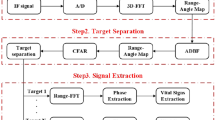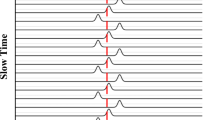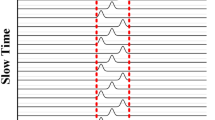Abstract
A contact-free people walk identification has numerous applications in surveillance and suspicious activity detection to take the precautionary actions. This paper presents a millimeter-wave radar-based automated system for walk type identification in which the received complex radar signals are decomposed using flexible analytic wavelet transform. The Correntropy and centered temporal correntropy features are computed for the decomposed components of radar signals and followed by students t-test based feature ranking. The classification is done using ensemble subspace discriminant classifier with classifier fusion. Six different types of walk namely, slow walk (SW), fast walk (FW), slow walk with hand in pocket (SWHP), slow walk with swinging hands (SWSH), walk with a limp (WL), and walk hiding bottle (WHB) are considered for walk identification. Six different combinations of different types of walk are formed to develop a robust system for accurate identification in different scenarios. The proposed method achieved 85.5% accuracy to classify all six classes and 100% accuracy to classify SW and FW. In terms of activity focused identification, 100% accuracy is achieved using the proposed system to classify SWHP, SWSH, WL, and WHB classes. The classification performance is better than the compared methods for the considered walk activity combinations in terms of accuracy, sensitivity, and specificity.









Similar content being viewed by others
Data Availability
All data analyzed to developed the method is referred properly with consent and available at [10].
References
Jones M, Byun C, Johnson N, Seppi K (2022) Understanding the Roles of Video and Sensor Data in the Annotation of Human Activities. Int J Hum Comput Stud 1–15
Dong M, Chen L, Wang L, Jiang X, Chen G (2017) Uncertainty visualization for mobile and wearable devices based activity recognition systems. Int J Hum Comput Stud 33(2):151–163
Sharma RR, Pachori RB (2018) Time-frequency representation using IEVDHM-HT with application to classification of epileptic EEG signals. IET Sci Meas Technol 12(1):72–82
Dubey R, Sharma RR, Upadhyay A, Pachori RB (2023) Automated Variational Non-linear Chirp Mode Decomposition for Bearing Fault Diagnosis. IEEE Trans Industr Inform 19:10873–10882
Sharma RR, Kumar M, Maheshwari S, Ray KP (2020) EVDHM-ARIMA-based time series forecasting model and its application for COVID-19 cases. IEEE Trans Instrum Meas 70:1–10
Ding C, Zhang L, Chen H, Hong H, Zhu X, Fioranelli F (2023) Sparsity-based Human Activity Recognition with PointNet using a Portable FMCW Radar. IEEE Internet Things J
AWR1642 single chip 77 and 79 GHz FMCW radar sensor . https://www.ti.com/lit/ds/symlink/awr1642.pdf?ts=1645445809438, [Online; accessed 21-February-2022]
DCA1000 EVM data capture card. https://www.ti.com/lit/ug/spruij4a/spruij4a.pdf?ts=1645679284467. [Online;accessed 24-february-2022]
Jankiraman M (2018) FMCW Radar Design. Artech House
Gambi E, Ciattaglia G, De Santis A, Senigagliesi L (2020) Millimeter wave radar data of people walking. Data in brief 31:105996
Bayram I (2012) An analytic wavelet transform with a flexible time-frequency covering. IEEE Trans Signal Process 61(5):1131–1142
Liu W, Pokharel PP, Principe JC (2006) Correntropy: A localized similarity measure. In: The 2006 IEEE international joint conference on neural network proceedings, pp. 4919–4924, IEEE
Li **nyu, He Yuan, **g **aojun (2019) A survey of deep learning-based human activity recognition in radar. Remote Sens 11(9):1068
Attal F, Mohammed S, Dedabrishvili M, Chamroukhi F, Oukhellou L, Amirat Y (2015) Physical human activity recognition using wearable sensors. Sensors 15(12):31314–31338
Huang X, Dai M () Indoor device-free activity recognition based on radio signal. IEEE Trans Veh Technol 66(6):5316–5329
Yang X, Tian Y (2016) Super normal vector for human activity recognition with depth cameras. IEEE Trans Pattern Anal Mach Intell 39(5):1028–1039
Markman A, Shen X, Javidi B (2017) Three-dimensional object visualization and detection in low light illumination using integral imaging. Opt Lett 42(16):3068–3071
Wang J, Chen Y, Hao S, Peng X, Hu L (2019) Deep learning for sensor-based activity recognition: A survey. Pattern Recognit Lett 119:3–11
Chen Z, Li G, Fioranelli F, Griffiths H (2018) Personnel recognition and gait classification based on multistatic micro-Doppler signatures using deep convolutional neural networks. IEEE Geosci. Remote. Sens. Lett 15(5):669–673
Cippitelli E, Fioranelli F, Gambi E, Spinsante S (2017) Radar and RGB-depth sensors for fall detection: A review. IEEE Sens J 17(12):3585–3604
Swami P, Jain A, Goswami P, Chitnis K, Dubey A, Chaudhari P (2017) High performance automotive radar signal processing on TI’s TDA3X platform. In: 2017 IEEE Radar Conference (RadarConf), pp. 1317–1320. IEEE
Vandersmissen B, Knudde N, Jalalvand A, Couckuyt I, Bourdoux A, De Neve W, Dhaene T (2018) Indoor person identification using a low-power FMCW radar. IEEE Trans. Geosci. Remote Sens 56(7):3941–3952
Kuncheva LI (2014) Combining pattern classifiers: methods and algorithms. John Wiley & Sons
Woods K, Kegelmeyer WP, Bowyer K (1997) Combination of multiple classifiers using local accuracy estimates. IEEE Trans Pattern Anal Mach Intell 19(4):405–410
Hu Y, Li F, Li H, Liu C (2017) An enhanced empirical wavelet transform for noisy and non-stationary signal processing. Digit Signal Process 60:220–229
Gilles J (2013) Empirical wavelet transform. IEEE Trans Signal Process 61(16):3999–4010
Huang NE, Shen Z, Long SR, Wu MC, Shih HH, Zheng Q, Yen NC, Tung CC, Liu HH (1998) The empirical mode decomposition and the Hilbert spectrum for nonlinear and non-stationary time series analysis. Proceedings of the Royal Society of London. Series A: mathematical, physical and engineering sciences 454(1971):903–995
Senigagliesi L, Ciattaglia G, De Santis A, Gambi E (2020) People walking classification using automotive radar. Electronics 9(4):588
Liu W, Pokharel PP, Principe JC (2007) Correntropy: Properties and applications in non-Gaussian signal processing. IEEE Trans Signal Process 55(11):5286–5298
Kwon Jihoon, Kwak Nojun (2019) Radar Application: Stacking multiple classifiers for human walking detection using micro-Doppler signals. Appl Sci 9(17):3534
Fioranelli F, Ritchie M, Griffiths H (2016) Performance analysis of centroid and SVD features for personnel recognition using multistatic micro-Doppler. IEEE Geosci Remote Sens Lett 13(5):725–729
Palffy A, Dong J, Kooij JFP, Gavrila DM (2020) CNN based road user detection using the 3D radar cube. IEEE Robot Autom Lett 5(2):1263–1270
Kim TK (2015) T test as a parametric statistic. Korean J Anesthesiol 68(6):540–546
Abdollahi J, Nouri-Moghaddam B (2022) A hybrid method for heart disease diagnosis utilizing feature selection based ensemble classifier model generation. Iran J Comput Sci 5(3):229–246
Bhavanasi G, Werthen-Brabants L, Dhaene T, Couckuyt I (2022) Patient activity recognition using radar sensors and machine learning. Neural. Comput. Appl 34(18):16033–16048
Ding W, Guo X, Wang G (2021) Radar-based human activity recognition using hybrid neural network model with multidomain fusion. IEEE Trans Aerosp Electron Syst 57(5):2889–2898
Werthen-Brabants L, Bhavanasi G, Couckuyt I, Dhaene T, Deschrijver D (2022) Split BiRNN for real-time activity recognition using radar and deep learning. Sci Rep 12(1):7436
Gunes O, Ege M, Morgül Ö (2022) Ground target classification using mmWave radar with bidirectional long short-term memory networks. J Appl Remote Sens 16(4):044527
Yu C, Xu Z, Yan K, Chien YR, Fang SH, Wu HC (2022) Noninvasive human activity recognition using millimeter-wave radar. IEEE Syst J 16(2):3036–3047
Kukkala VK, Tunnell J, Pasricha S, Bradley T (2018) Advanced driver-assistance systems: A path toward autonomous vehicles. IEEE Consum Electron Mag 7(5):18–25
Narayanan RM (2008) Through-wall radar imaging using UWB noise waveforms. J Frank Inst 345(6):659–678
Wang J, Jiang X, Meng Q, Saada M, Cai H (2022) Walking motion real-time detection method based on walking stick, IoT, COPOD and improved LightGBM. Appl Intell 1–19
Li N, Zhao X (2023) A multi-modal dataset for gait recognition under occlusion. Appl Intell 53(2):1517–1534
Sharma, Rishi Raj and Kumar, Kaku Akhil and Cho, Sung Ho (2023) Novel Time-Distance Parameters Based Hand Gesture Recognition System Using Multi-UWB Radars. IEEE Sens Lett 7(5):1–4
Funding
No funds, grants, or other support was received.
Author information
Authors and Affiliations
Contributions
All authors contributed equally in this manuscript.
Corresponding author
Ethics declarations
Conflict of Interest
The authors have no relevant financial or non-financial interests to disclose. The authors also have no competing interests to declare that are relevant to the content of this article.
Additional information
Publisher's Note
Springer Nature remains neutral with regard to jurisdictional claims in published maps and institutional affiliations.
Rights and permissions
Springer Nature or its licensor (e.g. a society or other partner) holds exclusive rights to this article under a publishing agreement with the author(s) or other rightsholder(s); author self-archiving of the accepted manuscript version of this article is solely governed by the terms of such publishing agreement and applicable law.
About this article
Cite this article
Sharma, R.R., Aravind, G. & Dubey, R. Radar based automated system for people walk identification using correlation information and flexible analytic wavelet transform. Appl Intell 53, 30746–30756 (2023). https://doi.org/10.1007/s10489-023-05159-2
Accepted:
Published:
Issue Date:
DOI: https://doi.org/10.1007/s10489-023-05159-2




